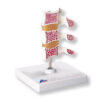1. Flat feet/Fallen Arch
Flat feet is a condition whereby the arches of the foot are significantly low or in some cases not there at all. It is commonly described as fallen arches and causes the person to over-pronante – roll onto the inner side of their foot- when walking. This can place a strain on the ligaments making walking difficult and sometimes painful.

What causes flat feet?
Flat feet can be caused by a number of different things.
- Hereditary
- Weak arch
- Arthritis
- Age – Wear and tear of the tendon.
What are the symptoms of flat feet?
Pain on the bottom of the foot is usually experienced which can be exasperated by wearing shoes. Pain in the hips legs and knees is also common.
How is flat feet treated?
Wearing orthotics with an arch support can help combat the problem of flat feet.Physio Needs do a range of orthotics that are popular with sufferers of flat feet.
2. Heel Spurs
A heel spur is a protrusion caused by a calcium deposit on the underside of the heel. This condition can cause heel pain and is often associated with plantar fasciitis.
What causes heel spurs?
Heel spurs are caused by a build of calcium deposits on the underside of the heel bone. They are often caused by repeated tearing of the membrane that covers the heel bone which is why the condition is common in athletes. Walking, running, jumping, flat feet, high arches and excess weight can also contribute to this condition.
What are the symptoms of heel spurs?
Heel spurs usually cause consistent or intermittent pain on the underside of the foot, particularly when walking running or jogging. The area when the heel spur has formed can often become tender and inflamed. The pain is usually described as feeling like a sharp pin is being stuck into the heel.
How are heel spurs treated?
Heel spurs can be treated effectively with non surgical methods, however in some cases surgery may be required. Consult your GP or Physiotherapist to get a correct diagnosis. Non-surgical treatment options:
- Wearing gel heel cradles or gel heel pads.
- Taping or strapping the stressed muscles and tendons.
- Wearing prescriptive shoes.
- Physiotherapy.
Physio Needs do a range of gel heel pads to help alleviate the symptoms associated with heel spurs




